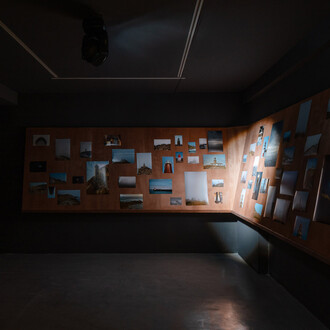Blink, blink, blink, and it’s there. Blink again, and you see nothing. It has vanished, but it was there. You know it was there, flickering in front of your eyes. You close them again, softer. You squeeze them shut, as if trying to forget what you just saw. You squeeze tighter, and everything turns magenta; red and burgundy. But no matter how hard you try, you can’t reach complete darkness. You can’t erase the picture imprinted on your memory. You open your eyes again, slowly. A burning light sneaks through your eyelashes. Blink, blink, blink, and there it is. Blink again, and again: nothing. Was it real, or just a trace of that previous image?
Since 1980, 78,545 people have been buried on Hart Island. That is what it says on the The Hart Island Project’s website. This island lies in the East River near Manhattan, between The Bronx and Queens, and now functions as NYC’s public cemetery. However, since the late 1860s it is known as one of the largest mass graves in the United States: a burial place for anonymous—unclaimed, unidentified, or just “non-regular”—people that has been in use for more than a century. Over the decades, thousands of histories have been locked here, leaving a deep blank in the city’s genealogy and collective imagery. When you turn your gaze towards the river’s horizon, the island seems to misshape, floating between sky and water. You might call it a mirage, an optical illusion, or even a consequence of high temperatures—yet another side effect of modern life management. But perhaps it’s just a sign that this place was forced to oblivion; that it’s a public monument to abandonment, filled with blinking souls that are claiming their right to recognition.
Through a sequence of landscapes, still lifes and portraits, the exhibition Hart Island by Willa Wasserman (Evansville, 1990) attempts to reach that which cannot be represented. Two large-scale paintings of Hart Island, along with a small work based on an image of an IDF armored bulldozer, welcome us into the exhibition space, delineating a fragile yet brutal sense of distance, of impossibility. Not so far away, a letter from Mara Hassan discreetly waits to be read. Beyond these works we encounter the portrait of Sunsiaré, facing the reclining figures of Maxelle and E., who seem to transcend this withdrawn feeling, leaning into proximity. Death becomes a collective matter, a concern of the living or even a responsibility. After a series of allegorical still lifes, we find, however, a character that summons a fundamental melancholy—that unbridgeable distance between the inside and the outside. The aesthetic and historical particularities of this enclave, Hart Island, lead Wasserman to explore the tension between the political quest for representation—highlighting the urge to name things properly, to expose how certain subjectivities are still ignored by our social structures—and the formal, even perceptual, mechanisms of the representational process. In the words of the artist: “while painting from observation, I have this persistent illusion: that I can see what I miss, that I can see what I can’t”.
Blink, blink, blink, it’s not really there. Blink, blink again: it is fading. You are not so sure, it’s hard to tell. It’s too sunny today—the landscape itself is blinking. Hot waves of air cross the river. Perhaps you can’t trust your gaze any longer. Would you stop looking at that crying land just because it’s too bright? Just because you shouldn’t be looking at it? You are miles away. You are miles away but it keeps flickering. Is it moving away or getting closer?
(Text by Lu Millet)
















